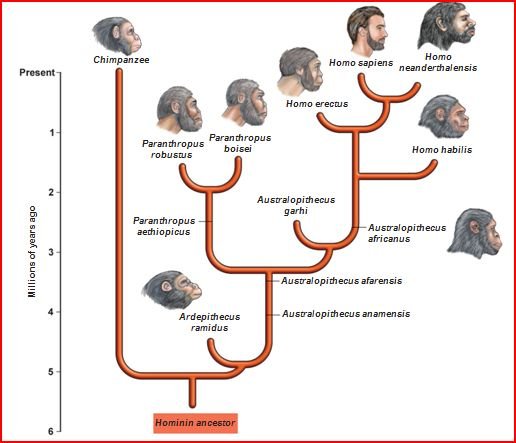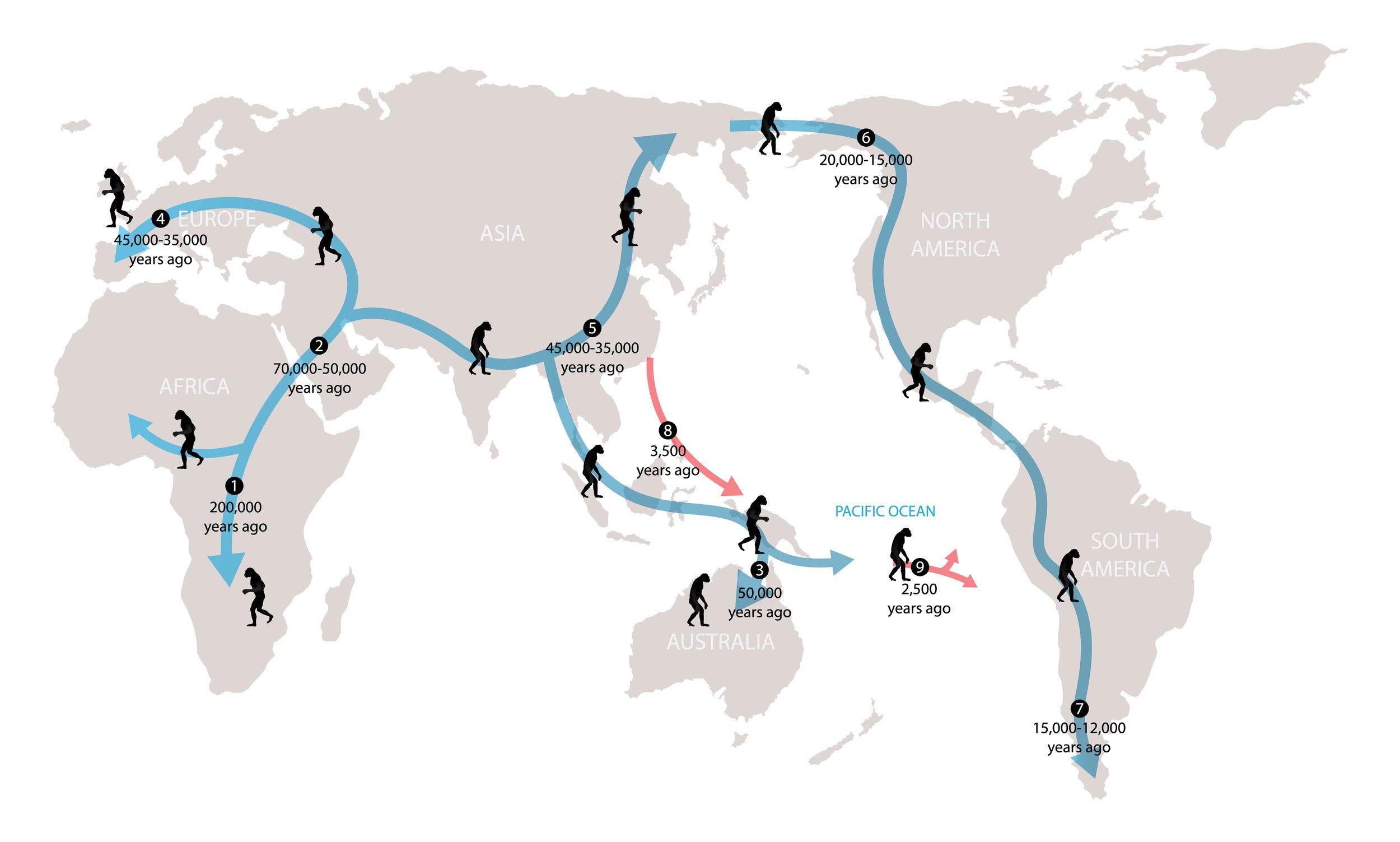The Silly Stuff
Once upon a time, before Man wrote,
Nothing happened of much note.
Well, that’s not true, as I will show,
The problem is there’s not much we know.
They didn’t leave us words of deeds,
Just bones and stones and a few bright beads.
But we do know some incredible things,
They invented tools and Buffalo wings.
Okay, that last one is a whopping lie,
But what about clothes, boats and dye?
Prehistory is what we call this time,
When not one soul could write or rhyme.
So back we go, deep into the past,
When humans evolved, but not very fast.
Millions and millions of years went by,
As climates changed and became more dry.
And when humans learned to stand up tall.
The first thing they did was play football!
by Nate Wrey
The Serious Stuff
What is Prehistory and how do humans fit in?
Writing has not always existed. It had to be invented by some bright spark or two. And, before that time, we know very little about the people who lived, not even their names. All we can do to understand their lives is study what they left behind in the soil or through tales passed from generation to generation. We call this time before writing the prehistoric period and it stretches back, with respect to humans, six million years to the origin of our species. Once humans recorded things through writing, and later generations could refer to these records, we entered the historic era (‘pre’ simply means ‘before’, hence pre-historic).
Humans originated in East Africa, evolving from apes, long after the dinosaurs became extinct. During a change in the climate, grasslands became more common, and some apes moved out of the trees and into this environment looking for food. Living on the ground, they had to be careful not to get caught and eaten by other wild beasts. Can you imagine an animal, a bit like a chimpanzee, standing on its back legs to watch out for these beasts over the tall grass? Those that could stand tallest, run fastest, or see farthest had a better chance of surviving. They passed these helpful traits on to their children, so that after millions of years and many, many generations, those that survived possessed all the best characteristics to suit this environment. In incredibly simple terms this is how apes evolved into humans to stand upright and travel further for a variety of food across the grasslands.
There have been many species of humans (we know of at least 20). They differed in height, some with smaller brains, some with a lot more hair and some we hardly know anything about. The collective term for this family of humans is hominins. The humans of today - that’s you and me - belong to the species called Homo Sapiens. No other species survives, which is sad. But long ago a few different species co-existed at the same time.
At some point in our story, humans added meat to their diet. The extra protein helped develop their bodies and brains (today we know of other sources of protein, so don’t have to eat meat if we don’t want to). Bigger brains and the design of our hands, which were no longer required for hanging on to branches, gave humans an advantage. With their superior intelligence, they could grip and use material to help them achieve things, such as hunting prey or collecting other food. In time, they learned to shape things for a specific purpose, creating cutting, grinding or digging tools. We enter the Stone Age.
Depiction on Australopithecus Afarensis, an early human
With the added advantage of tools, humans became even more successful, allowing their numbers to grow. This put pressure on the available resources, meaning people had to travel wider to find food. Family groups will have slowly split, spreading out, taking their skills with them, adapting to other environments. People from prehistory would have been much more part of nature than most of us are today. It was a fragile existence and life was short.
Replicas of stone tools
An important factor that sets humans apart from animals is our ability to speak. However, scientists are undecided, and have no conclusive evidence for when we developed this skill. The spreading of knowledge and techniques, such as tool making, would certainly have been assisted by verbal communication, and speaking may even have fomented such activities in the first place. But this remains one theory among many.
The Earth was not in an ice age when humans first emerged, but it was for a large part of the human story, beginning 2.4 millions years ago (the Earth has had a number of ice ages but only the last one directly impacted on humans). The undulating nature of an ice age - with ice caps growing and shrinking and temperatures cooling and warming - will have played an important role in human advancement, as climate changes force nature to adapt to survive or face extinction. As more of the world’s moisture was trapped in the ice caps, there was less rain and more droughts. People who once relied on regular seasons and weather for their hunting and food gathering will have struggled if the rains didn’t come or the animals they hunted died out. It may have prompted the extraordinary movement of humans around the world.
Modern humans not of African descent are believed to have migrated out of Africa between 70 to 50 thousand years ago. However, they weren’t the first humans to do so and it is thought other species of humans achieved this feat, as well as other Homo Sapiens groups. For example, stone tools have been found in China dating to 2.12 million years ago, long before Homo Sapiens emerged as a species or left Africa. Again, the Ice Age will have helped this movement as sea levels were lower and where there are seas today, such as the English Channel, there would have been land, providing a bridge to places now cut off by water.
Modern human migration around the world
It is important to keep in mind that nothing happened quickly in the development of humans. Tools may have started as a simple stick to collect termites on as a nice snack (as some chimpanzees have learned to do today) or dropping stones to crack nuts. Hundreds of thousands of years or more may have passed before humans were knapping flint into weapons. Much of human existence is not about advancement but simple survival against the whims of changing climates. The fact all but one human species are now extinct shows just how hard that was. The majority of achievements touched upon in ‘Mooge’ took place in the last 30,000 years and that, in prehistory terms, is a relatively short period.
The ‘later’ advancements for humans in prehistory, such as the wheel, farming and writing, took place in fertile river valleys when the climate was warmer, the ice caps had retreated, food was more plentiful, birth rates higher and human societies were becoming more sophisticated and dependent on each other, with the capacity for some members of society to dedicate their time to specialist areas not related to food collection. Humans, who had been hunter-gathers for all of their existence, always on the move, always having to follow their food source, could stay in one place and focus their attention on things such as buildings. Eventually, these societies formed cities and civilisations, leading us into the age of history.
Our understanding of when and where things first occurred is changing all the time as archaeologists and scientists discover new finds. Just today (25/2/22), I’ve read an article about Oxford scientists mapping the human genome back to a specific location in Sudan, claiming this as the ancestral starting point for us all. The following video explains it further:
And read about this discovery from Kenya as reported by the BBC (10/2/2023) Ancient stone tools found in Kenya made by early humans - BBC News and this story of 1/2 million year old wood houses found in Zambia Half-million-year-old wooden structure unearthed in Zambia - BBC News
Author’s note: I am not an academic, nor do I profess any in-depth knowledge in the subject of prehistory. As previously explained, Mooge is written with tongue-in-cheek to simply stir curiosity and interest in the young, not to impart fact. I have built these webpages to offer a little fact for those hoping to foster that curiosity and interest. It is based on my learning and understanding from books and TV. Below, I include some sources I have appreciated - Nate Wrey.
Further reading/viewing recommendations:
Visit the Natural History Museum’s page on Human Evolution
The Early Human World, Peter Robertshaw and Jill Rubalcaba, Oxford University Press, 2004
Ancestors: A Prehistory of Britain in Seven Burials, Alice Roberts, Simon and Schuster UK, 2022
After the Ice: A Global Human History 20,000-5,000 BC, Steve Mithen, W&N, 2004
Prehistory: A Very Short Introduction, Chris Gosden, Oxford University Press, 2018
The Origin of our Species, Chris Stringer, Penguin, 2012
The Ascent of Man, J Bronowski, BBC, 1973
Origins of Us, Alice Roberts, BBC,
A History of Ancient Britain, Neil Oliver, BBC, 2011






